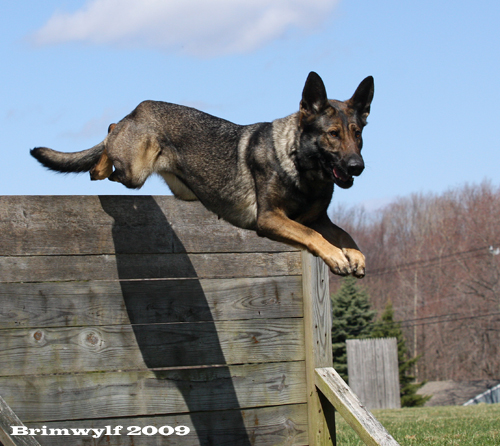Conditioning and Care of the Athletic Dog
Many dogs these days lead very busy lives. In order to perform at their best, they need to be cared for like athletes. There are several factors which affect performance, those that are internal to the dog, such as genetics, physiology and psychology, and those that are external such as food, training, and type of sport.
The first step is to evaluate what a dog is capable of. This requires looking at his structure and movement to see if he will able to stand up to the work required. An evaluation of his temperament and willingness to work is also necessary. Much of the basic make-up of the dog is inherited from his parents. We can influence his structure by correct feeding and conditioning but the underlying anatomy and gait must be sound. We can influence his temperament and willingness by socialization and ensuring the dog understands what we require, that our training is clear and fair, but if he inherited shyness from his ancestors, he will never be bold and courageous in all situations.

Conditioning a dog for sport should include aerobic activity, some core work and also some of the exercises that they will need in the sport. Aerobic fitness can be attained with hiking, swimming, running blinds, running alongside a bicycle or a treadmill. Chasing a ball is an area of contention, since dogs often turn the same way each time and also place a lot of stress on the shoulders when grabbing for the ball and making the turn. Throwing a ball into longer grass can help alleviate that, but also ensure that the ground is not too hard for constant running. Core work with dogs can be a little more challenging, hiking over varied terrain can help, also various exercises such as T-touch ground work, cavaletti poles, and work on inflated balls can be done. Remember to incorporate exercises that are necessary for the sport like the 1 meter jump and the wall. It is important to teach the dog to manage these obstacles in low drive, so they can learn good jumping and scaling technique as well as specific strength for those activites.
It is important to warm up and cool down before and after exercise. Warm-up and stretching can reduce the risk of injury. Typically an IPO dog will need 10-15 minutes of walking or slow jogging to warm up. If you do a lot of heeling, you should take special care to do some passive stretches with the neck and back bending in the opposite direction or alternatively teach heeling on both sides. After warm-up or after exercise, it is a good idea to do some passive stretches, you can also see if he is feeling sore, as he might try to pull away, a couple of days rest could prevent a much more serious injury.
A trip to a chiropractor or sports therapist can also help with performance in sport. They can also identify weaknesses in structure and musculature which can help with designing a specific program for each dog.
In warm summers (above 70F), the dog should be fully conditioned to the environment, work should be gradually built up. The dog should spend as much time outdoors, in the conditions he will work in, as possible, this helps him become acclimatized. Know how to cope with an emergency.
Don't feed puppies for rapid growth, there is no evidence to suggest that this will increase size at maturity, and there are correlations between speed of growth and developmental conditions in susceptible animals. You don't know whether your pup is pre-disposed to any of these conditions, so why take the risk! Recent research has also suggested a link between over-supplementation of calcium and developmental problems. It has been suggested that care should be taken when switching a pup to adult food - that the amount of food required to maintain the correct weight does not contain too much calcium. Keep adults lean, this helps them to avoid unnecessary strain on the joints and helps them to dissipate heat while working. Many people disagree on supplements, but Omega-3 supplementation has been shown to improve health of joints and cartilage in sporting dogs.
Water should always be available except immediately after strenuous exercise. The dog can be given a little cool, but not ice cold, water just after the activity, but he should be fully cooled off and his heart rate back to normal before offering a full bowl. Sometimes a dog will gorge himself on cold water straight after exercise and bloat. Check out some of the supplements to be given after exercise in water, research has shown that these can help with recovery, and also can be useful for dogs that refuse water when traveling.
Online Reading:
Recommended Reading:
These links are adverts for products for sale on Amazon.com.
As an Amazon Associate I earn from qualifying purchases.
These earnings help pay
for hosting for this website.